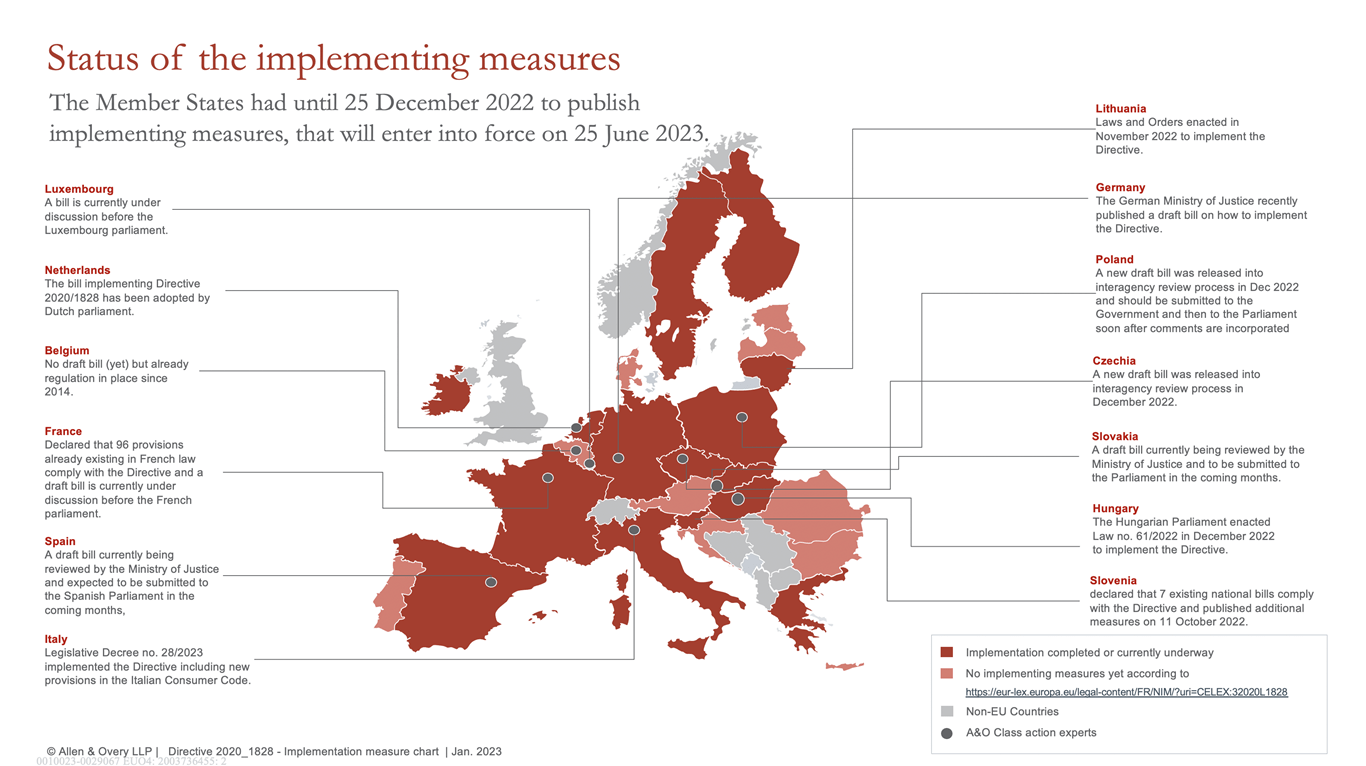Directive (EU) 2020/1828: A new framework for EU class actions
Related people




Eline Ulrix
Senior Associate
Brussels

Lauren Rasking
Senior Associate
Brussels

Erwan Poisson
Partner
Paris

Julie Metois
Counsel
Paris

Dr Wolf Bussian
Managing Partner Germany
Frankfurt am Main

Stefanie Günther
Senior Associate
Frankfurt am Main

Dr Anja Schelling
Counsel
Frankfurt am Main

Martina Rossi
Senior Associate
Milan

Balazs Sahin-Toth
Counsel
Budapest

Robert Pavlu
Counsel
Prague

Thomas Berger
Partner
Luxembourg

Lena Wanlin
Associate
Luxembourg

Tim Sweerts
Senior Associate
Amsterdam

Bartosz Merczynski
Partner
Warsaw

Monika Murawska
Senior Associate
Warsaw

Javier Mendieta
Partner
Madrid

Jose Luis Terron
Counsel
Madrid

Richard Macko
Associate
Bratislava
Headlines in this article
Related news and insights
Publications: 23 November 2023
Blog Post: 02 February 2022
Netherlands: One of the first major privacy class actions dismissed by Court of Amsterdam
Publications: 10 March 2021
The New Deal for Consumers: our outline of the key pillars and initial steps to get ready
For many years now, the EU has sought to create a collective redress mechanism across the EU market. Half of the EU member states have little or no such mechanism.
Class action lawsuits and representative actions are established procedural laws in the United States. Both have entered the European legal framework, in response to a global shift toward group litigation.
These collective actions have become more common in commercial litigations. These cases can involve (alleged) high volume consumer rights breaches, which can affect businesses in an industry and sector, from financial institutions to pharmaceuticals and technology majors.
The Directive (EU) 2020/1828 on representative actions could change the dynamic of these actions in the EU, with several EU member states adopting a consumer class action regime for the first time.
Background on class actions in the EU
After the Injunctions Directive 2009/22/EC and a non-binding Recommendation on collective redress mechanisms in 2011, the European Commission published a “Fitness Check” of EU consumer and marketing law in 2017.
The report concluded the Injunctions Directive had considerable shortcomings such as its costs and complexity.
Additionally, a report by the European Commission in 2018 found there had been limited follow-up to the Recommendation in legislative terms.
The limited impact of the Injunctions Directive and the Recommendation during a period in which several mass harm cases occurred in Europe prompted the European Commission to announce a “New Deal for Consumers” in April 2018.
Directive (EU) 2020/1828
This has resulted in Directive (EU) 2020/1828 on representative actions for the protection of the collective interests of consumers and repealing Directive 2009/22/EC (the “Directive”), which entered into force on 24 December 2020.
The Directive aims to supplement, not replace, any existing national collective action mechanisms.
Member States can incorporate the Directive into an existing national representative action mechanism. They can also opt to design a new mechanism.
Moreover, the Directive aims at minimum harmonisation. This means Member States may introduce broader regimes than under the Directive, with higher risk for defendants.
The main impact of the Directive is to allow individual consumers from a Member State to join proceedings in other Member States on an opt in basis (being however noted that if an injunction order is sought, an opt in or opt out mechanism is not required).
The main features of the Directive are the following:
- The Directive applies to infringements of a list of Union laws listed in Annex I to the Directive. The scope of the Directive is considerably broader than the Injunctions Directive and notably includes data protection, financial services, energy, telecommunications, as well as travel and tourism.
- Member States may decide on whether they implement an opt-in or opt-out system or a combination of the two for redress claims.
- Member States must enable qualified entities, designated as such by the Member State in advance or ad hoc, to bring class actions in their national courts. Courts must be enabled to issue injunction orders (for provisional or definitive relief) as well as redress orders (for example in the form of monetary compensation, contract termination or reimbursements).
As a result, the Directive seeks to strike a balance between access to justice and procedural safeguards against abusive litigation.
As part of these safeguards, class actions may be brought only by qualified entities, punitive damages should be avoided and Member States must ensure that conflicts of interests are prevented.
The Directive also requires Member States to ensure that, where a qualified entity has provided reasonably available evidence sufficient to support a representative action, and has indicated that additional evidence lies in the control of the defendant or a third party, the defendant or the third party may be ordered to disclose such additional evidence, subject to confidentiality and proportionality safeguards.
This implies a broader scope of disclosure than many Member States currently permit outside follow-on antitrust damages claims, and many defendants could find the financial and human resources required to comply with it an unpleasant surprise.
Member States had to implement the Directive in their national law by 25 December 2022 and will apply these implementing provisions from 25 June 2023.
According to the EurLex website and our local experts’ review, as of the date of this article, only a few member states enacted implementing measures (e.g. Hungary, Slovenia, the Netherlands, Italy and Lithuania). Also, as of the date of this article, a draft bill is currently under discussion before the Polish parliament.
One member seems to consider that current national provisions comply with the Directive (France). Some national parliaments are still discussing draft bills (e.g. Luxembourg, Spain, Czechia, Slovakia and Germany).
Other member states have not yet published implementing measures.
Learn more about our Class Actions and Group Litigation practice and how we can support you.

Our experience
- The first French class action lawsuit in the financial sector in France
- The first follow-on class action lawsuit introduced resulting from a conviction by the Enforcement Committee of the French markets authority
- Mis-selling class action in the financial sector in the Netherlands
- Act on Model Case Proceedings in Disputes under Capital Markets Law (KapMuG)
- Mass claim in the truck sector in Germany